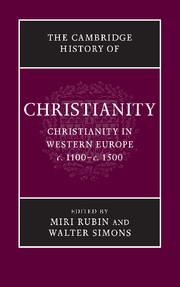Book contents
- Frontmatter
- Introduction
- PART I INSTITUTIONS AND CHANGE: 1100–1200
- PART II FORGING A CHRISTIAN WORLD, 1200–1300
- PART III THE ERECTION OF BOUNDARIES
- PART IV SHAPES OF A CHRISTIAN WORLD
- 15 Sacramental life
- 16 Religious soundscapes: liturgy and music
- 17 Images and their uses
- 18 Mary
- 19 Mysticism and transcendence
- PART V CHRISTIAN LIFE IN MOVEMENT
- PART VI THE CHALLENGES TO A CHRISTIAN SOCIETY
- PART VII REFORM AND RENEWAL
- Select bibliography
- Index
- Map 1 Western Europe c. 1100 – c. 1500
- Map 2 Universities of Europe
- References
17 - Images and their uses
from PART IV - SHAPES OF A CHRISTIAN WORLD
Published online by Cambridge University Press: 28 March 2010
- Frontmatter
- Introduction
- PART I INSTITUTIONS AND CHANGE: 1100–1200
- PART II FORGING A CHRISTIAN WORLD, 1200–1300
- PART III THE ERECTION OF BOUNDARIES
- PART IV SHAPES OF A CHRISTIAN WORLD
- 15 Sacramental life
- 16 Religious soundscapes: liturgy and music
- 17 Images and their uses
- 18 Mary
- 19 Mysticism and transcendence
- PART V CHRISTIAN LIFE IN MOVEMENT
- PART VI THE CHALLENGES TO A CHRISTIAN SOCIETY
- PART VII REFORM AND RENEWAL
- Select bibliography
- Index
- Map 1 Western Europe c. 1100 – c. 1500
- Map 2 Universities of Europe
- References
Summary
In the first half of the twelfth century, three men, all Benedictine monks, penned defences of Christian art. The first appears in a psalter dated c. 1120–39 and is a French paraphrase of a letter attributed to Pope Gregory the Great:
It is one thing to worship a picture and another to learn from the story of a picture what is to be worshiped. For what writing conveys to those who can read, a picture shows to the ignorant…and for that very reason a picture is like a lesson for the people.
This prayer book, known as the Saint Albans Psalter, was the first English manuscript in almost two hundred years to contain full-page painted scenes, and its scribe apparently felt that some justification for the lavish decoration was necessary. The second, by Rupert, abbot of Deutz (d. 1129), is a refutation of Jewish charges that Christian veneration of images amounted to idolatry. Rupert’s response was to emphasise the emotional impact and devotional efficacy of images: ‘While we externally image forth [Christ’s] death through the likeness of the cross, we [are kindled] inwardly to love of him…’ The third, an elaborate paean by Abbot Suger of Saint-Denis to the beauty and spiritual power of his newly rebuilt abbey church (c. 1144), implicitly counters those who saw art as a form of ‘distracting materialism’. Far from distracting us, Suger wrote, art draws our ‘dull minds’ to the sacred, ‘urging [them] upward from material things to the immaterial’.
Keywords
- Type
- Chapter
- Information
- The Cambridge History of Christianity , pp. 254 - 282Publisher: Cambridge University PressPrint publication year: 2009

